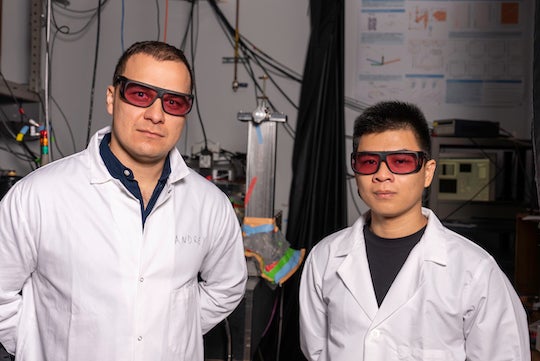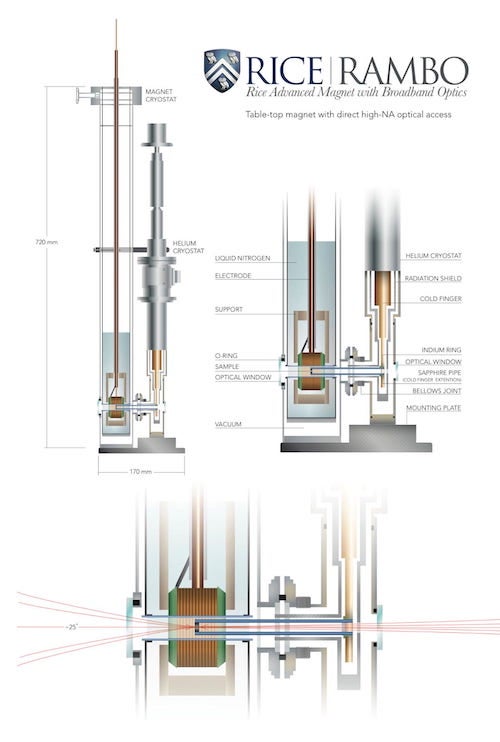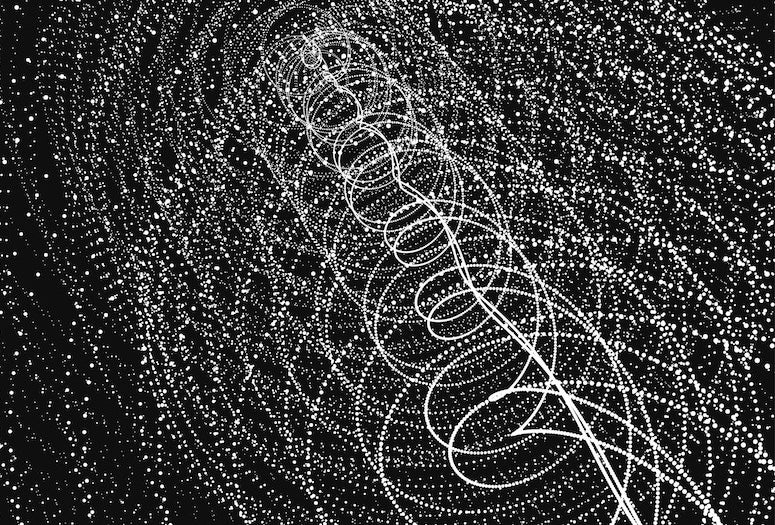by Kayt Sukel
Special to Rice News
Materials with enhanced thermal conductivity are critical for the development of advanced devices to support applications in communications, clean energy and aerospace. But in order to engineer materials with this property, scientists need to understand how phonons, or quantum units of the vibration of atoms, behave in a particular substance.

“Phonons are quite important for studying new materials because they govern several material properties such as thermal conductivity and carrier properties,” said Fuyang Tay, a graduate student in applied physics working with the Rice Advanced Magnet with Broadband Optics (RAMBO), a tabletop spectrometer in Junichiro Kono’s laboratory at Rice University. “For example, it is widely accepted that superconductivity arises from electron–phonon interactions.
“Recently, there has been growing interest in the magnetic moment carried by phonon modes that show circular motion, also known as chiral phonons. But the mechanisms that can lead to a large phonon magnetic moment are not well understood.”
Now an international team of researchers led by Felix Hernandez from Brazil’s Universidade de São Paulo and Rice assistant research professor Andrey Baydin has published a study detailing the intricate connections between the magnetic properties of these quantum whirling dervishes and a material’s underlying topology of the electronic band structure, which determines the range of energy levels that electrons have within it.
This finding adds to the growing body of knowledge on phonons, opening the door not only for more effective phonon manipulation via magnetic fields, but also for the development of advanced materials.
In a previous study, Baydin and colleagues applied a magnetic field to lead telluride, a simple semiconductor material. When they did so, they saw that the phonons stopped vibrating in a linear fashion and became chiral, moving in a circular motion.

“Chiral phonons interact with one another differently than phonons that move linearly,” Baydin said. “If we understood the properties of these interactions, we could make use of them. Different properties could realize different potential applications in materials.”
After noting that chiral phonons’ magnetic moment was quite small in the material they first focused on, the group wondered if changing the material’s topology ⎯ or electronic band structure ⎯ would impact magnetic properties. To answer this question, the researchers tested a new material called a crystalline topological insulator.
“We took the lead telluride and added tin to it,” Baydin said. “If you add enough, something called band inversion happens, creating topologically protected surface states. These materials are fascinating, because they are insulating in bulk but have conducting electronic surface states ⎯ a very promising feature that could be exploited in novel electronic devices.”
Additional experiments revealed that the chiral phonons’magnetic moment was two orders of magnitude larger in the topological material than in the material without such electronic topology.
“Our findings reveal compelling new insights into the magnetic properties of phonons in this material and emphasize the intricate connection between the magnetic properties of chiral phonons and the material’s underlying electronic band structure topology,” Baydin said. He added that the group plans to conduct further experiments to better understand other aspects of phonon behavior in the future.
Tay added that these results, which demonstrate that the magnetic moment of phonons is significantly enhanced in topological materials, can help materials scientists search and design materials with larger phonon magnetic moments as needed for different device applications.
“This observation provides new insights into how to control and manipulate phonon properties to change thermal conductivity,” Tay said. “Furthermore, the interplay between chiral phonons and electronic structure topology raises the possibility that the topological phase could be influenced by controlling the phonons.”
The research was supported by the National Science Foundation (1720595, 2114825), Rice University through the Brasil@Rice Collaborative Grant, the São Paulo Research Foundation (2018/06142-5, 2023/04245-0), Brazil’s National Council for Scientific and Technological Development (307192/2021-0, 302288/2022-8), the Alexander von Humboldt Foundation and the Japan Society for the Promotion of Science (20H05662).
- Peer-reviewed paper:
-
Observation of interplay between phonon chirality and electronic band topology | Science Advances | DOI: 10.1126/sciadv.adj4074
Authors: Felix G. G. Hernandez, Andrey Baydin, Swati Chaudhary, Fuyang Tay, Ikufumi Katayama, Jun Takeda, Hiroyuki Nojiri, Anderson K. Okazaki, Paulo H. O. Rappl, Eduardo Abramof, Martin Rodriguez-Vega, Gregory A. Fiete and Junichiro Kono
https://www.science.org/doi/10.1126/sciadv.adj4074 - Image downloads:
-
https://news-network.rice.edu/news/files/2023/12/231205_Science-Advances-Andrey-Baydin-and-Fu-Yang-Tay_Gustavo-5.jpg
CAPTION: Andrey Baydin (left) and Fuyang Tay (Photo by Gustavo Raskosky/Rice University)
https://bpb-us-e1.wpmucdn.com/news-network.rice.edu/dist/c/2/files/2020/08/0817_RAMBO2-Graphic-lg.jpg
CAPTION: A graphic illustrates the setup and functions for the Rice Advanced Magnet with Broadband Optics, or RAMBO, a unique instrument that lets researchers use pulsed-laser spectroscopy to examine the behavior of materials that are simultaneously cooled near absolute zero and subjected to a massive pulse of magnetic energy. (Image courtesy of Junichiro Kono Laboratory)
- Related stories:
-
Strong magnets put new twist on phonons:
https://news.rice.edu/news/2022/strong-magnets-put-new-twist-phonons
Rice’s RAMBO-II: A sequel better than the original:
https://news.rice.edu/news/2020/rices-rambo-ii-sequel-better-original - Links:
-
Junichiro Kono Laboratory: http://kono.rice.edu/
Department of Electrical and Computer Engineering: https://eceweb.rice.edu/
George R. Brown School of Engineering: https://engineering.rice.edu/
Applied Physics Graduate Program: https://appliedphysics.rice.edu/
Smalley-Curl Institute: https://sci.rice.edu/
- About Rice:
-
Located on a 300-acre forested campus in Houston, Rice University is consistently ranked among the nation’s top 20 universities by U.S. News & World Report. Rice has highly respected schools of architecture, business, continuing studies, engineering, humanities, music, natural sciences and social sciences and is home to the Baker Institute for Public Policy. With 4,574 undergraduates and 3,982 graduate students, Rice’s undergraduate student-to-faculty ratio is just under 6-to-1. Its residential college system builds close-knit communities and lifelong friendships, just one reason why Rice is ranked No. 1 for lots of race/class interaction, No. 2 for best-run colleges and No. 12 for quality of life by the Princeton Review. Rice is also rated as a best value among private universities by Kiplinger’s Personal Finance.

